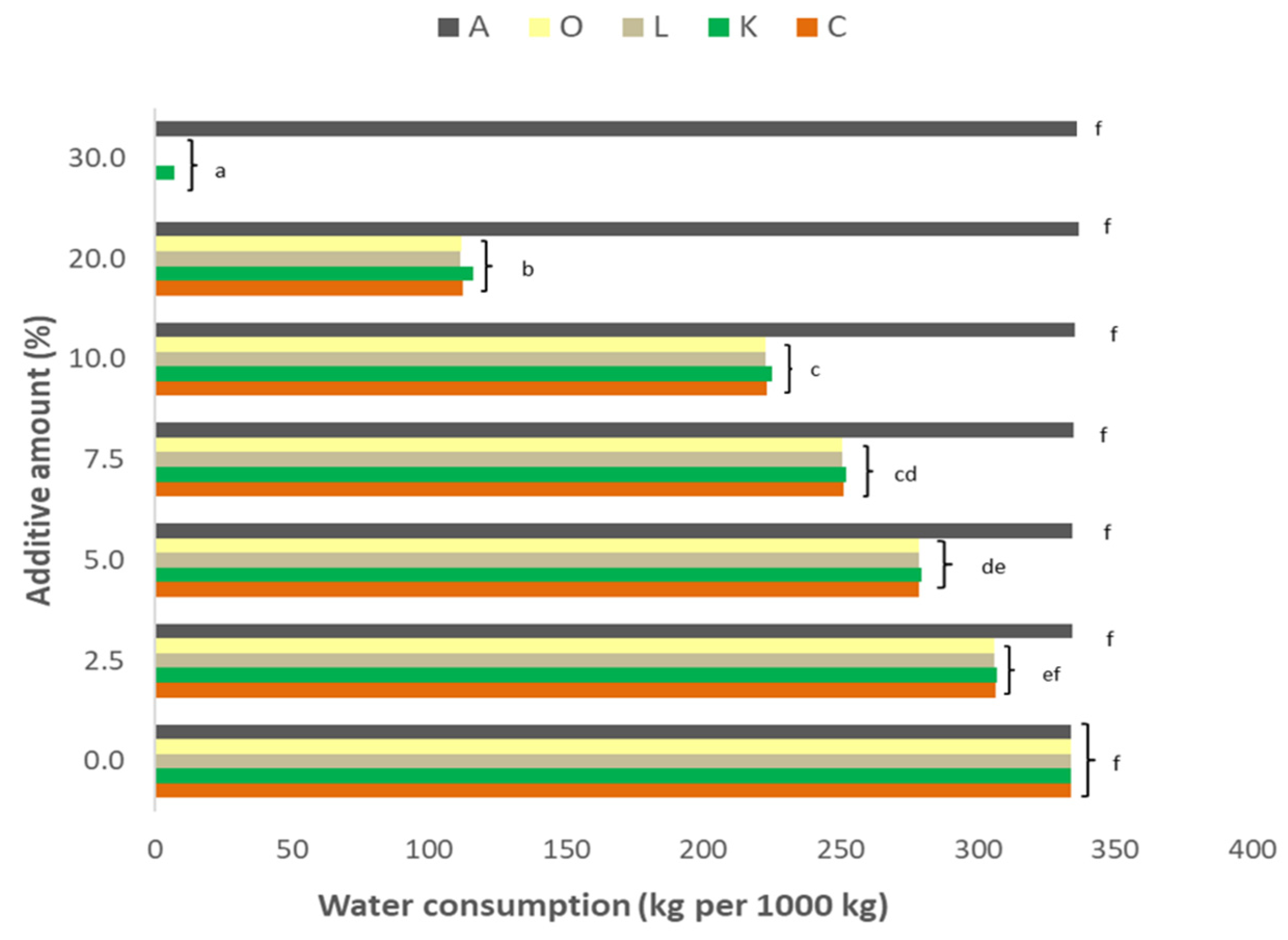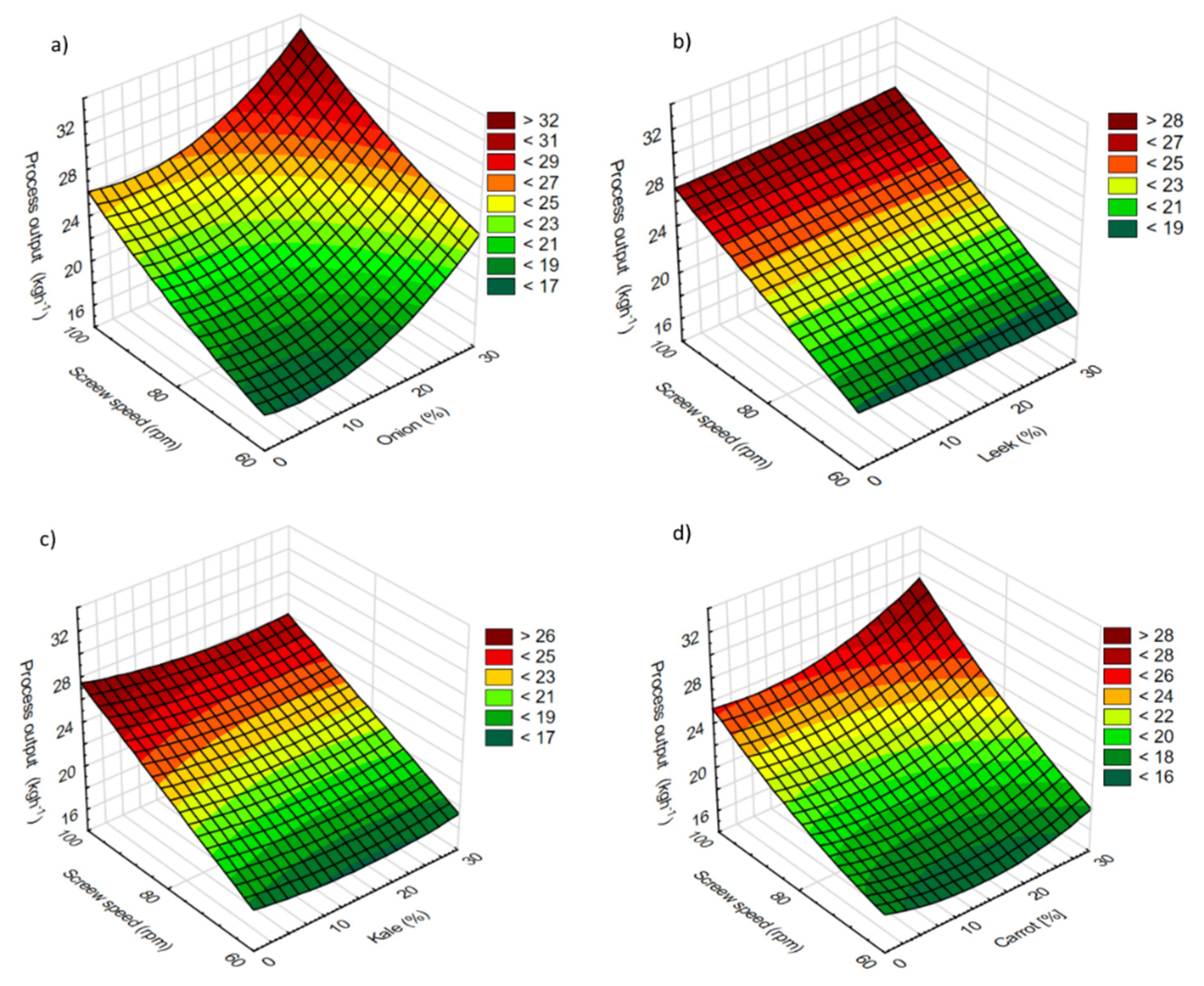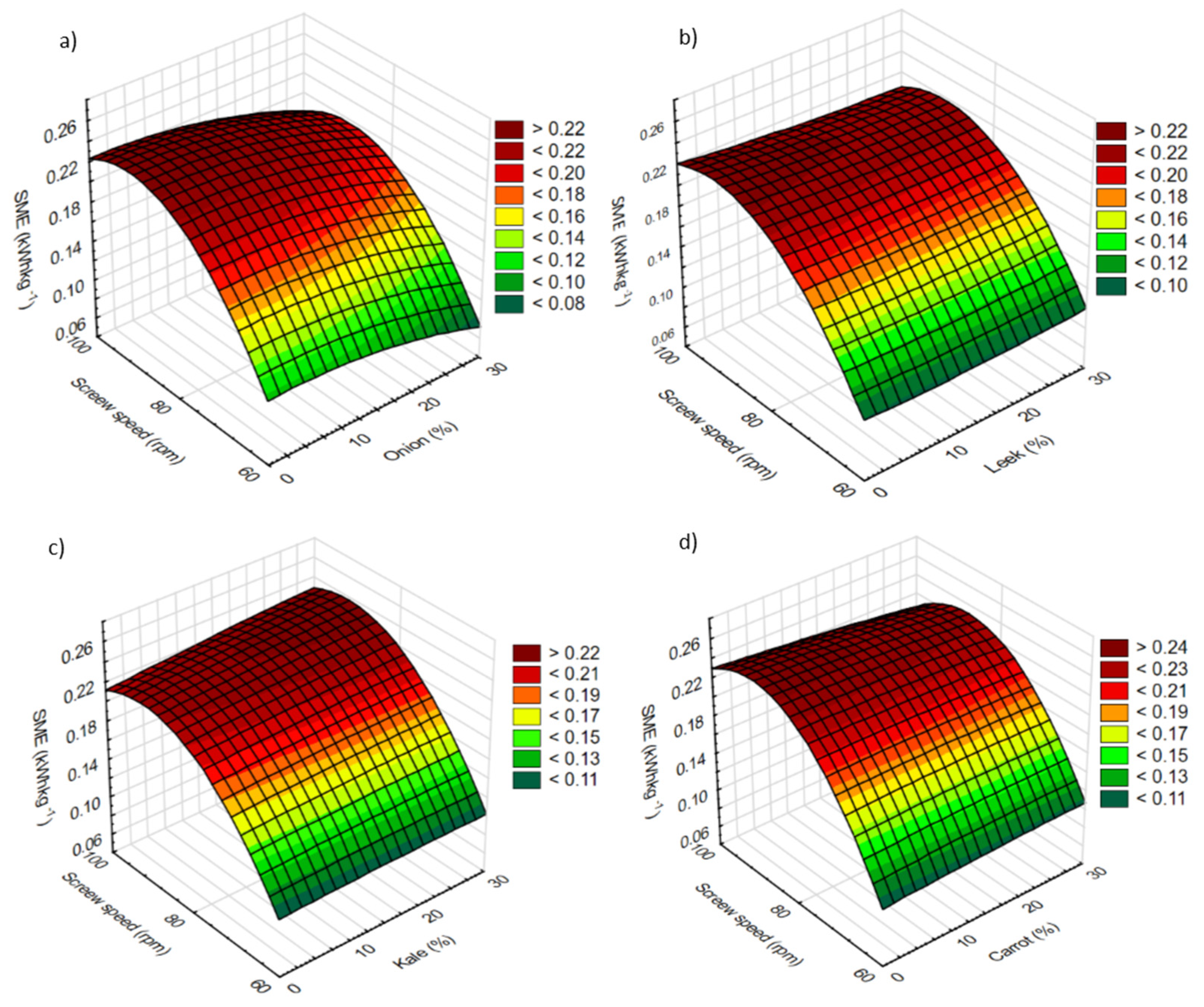Possibility to Save Water and Energy by Application of Fresh Vegetables to Produce Supplemented Potato-Based Snack Pellets
Abstract
1. Introduction
2. Materials and Methods
2.1. Raw Material and Processing
2.2. Calculation of Water Consumption
2.3. Processing Efficiency and Energy Consumption
2.4. Statistical Analysis
3. Results and Discussion
3.1. Water Requirements
3.2. Energy Requirements
4. Conclusions
Author Contributions
Funding
Conflicts of Interest
References
- Martzopoulou, A.; Komninos, N. The effect of solar energy on the environmental impacts and sustainability of food industry. J. Environ. Manag. 2019, 7, 303–321. [Google Scholar] [CrossRef]
- Nemati-Amirkolaii, K.; Romdhana, H.; Lameloise, M.L. Pinch methods for efficient use of water in food industry: A survey review. Sustainability 2019, 11, 4492. [Google Scholar] [CrossRef]
- Benhur, D.R.; Bhargavi, A.; Kalpana, K.; Vishala, A.D.; Ganapathy, K.N.; Patil, J.V. Development and standardization of sorghum pasta using extrusion technology. J. Food Sci. Technol. 2015, 52, 6828–6833. [Google Scholar] [CrossRef]
- Kręcisz, M. Energy consumption during production of corn extrudates in relation to the process parameters. Agric. Eng. 2016, 20, 125–131. [Google Scholar] [CrossRef]
- Matysiak, A.; Wójtowicz, A.; Oniszczuk, T. Process efficiency and energy consumption during the extrusion of potato and multigrain formulations. Agric. Eng. 2018, 22, 49–57. [Google Scholar] [CrossRef]
- Wójtowicz, A.; Zalewska-Korona, M.; Jabłońska-Ryś, E.; Skalicka-Woźniak, K.; Oniszczuk, A. Chemical characteristics and physical properties of functional snacks enriched with powdered tomato. Pol. J. Food Nutr. Sci. 2018, 68, 251–261. [Google Scholar] [CrossRef]
- Altan, A.; McCarthy, M.L.; Maskan, M. Evaluation of snack foods from barley–tomato pomace blends by extrusion processing. J. Food Eng. 2008, 84, 231–242. [Google Scholar] [CrossRef]
- Singha, P.; Muthukumarappan, K. Effects of processing conditions on the system parameters during single screw extrusion of blend containing apple pomace. J. Food Process Eng. 2017, 40, 1–11. [Google Scholar] [CrossRef]
- Correia, F.K.; Loro, A.C.; Zanatta, S.; Spoto, M.H.F.; Vieira, T.M.F.S. Effect of temperature, time, and material thickness on the dehydration process of tomato. Int. J. Food Sci. 2015, 970724. [Google Scholar] [CrossRef]
- Stojceska, V.; Ainsworth, P.; Plunkett, A.; İbanoğlu, E.; İbanoğlu, S. Cauliflower by-products as a new source of dietary fibre, antioxidants and proteins in cereal based ready-to-eat expanded snacks. J. Food Eng. 2008, 87, 554–563. [Google Scholar] [CrossRef]
- Stojceska, V.; Ainswirth, P.; Plunkett, A.; Ibanoglu, S. The effect of extrusion cooking using different water feed rates on quality of ready-to-eat snacks made from food by-products. Food Chem. 2009, 114, 226–232. [Google Scholar] [CrossRef]
- Makowska, A.; Mildner-Szkudlarz, S.; Obuchowski, W. Effect of brewer’s spent grain addition on properties of corn extrudates with an increased dietary fibre content. Pol. J. Food Nutr. Sci. 2013, 63, 19–24. [Google Scholar] [CrossRef]
- Ratti, C. Advances in Food Dehydration, 1st ed.; CRC Press: Boca Raton, FL, USA, 2008. [Google Scholar] [CrossRef]
- Holtz, E.; Ahrné, L.; Rittenauer, M.; Rasmuson, A. Influence of dielectric and sorption properties on drying behaviour and energy efficiency during microwave convective drying of selected food and non-food inorganic materials. J. Food Eng. 2010, 97, 144–153. [Google Scholar] [CrossRef]
- Alibas, I. Energy consumption and colour characteristics of nettle leaves during microwave, vacuum and convective drying. Biosyst. Eng. 2007, 96, 495–502. [Google Scholar] [CrossRef]
- Lue-lue, H.; Min, Z.; ArunS, M.; Dong-feng, S.; Guan-wei, T.; Shameel, T. Studies on decreasing energy consumption for a freeze-drying process of apple slices. Dry. Technol. 2009, 27, 938–946. [Google Scholar] [CrossRef]
- Snack Pellets Market by Type (Potato, Corn, Rice, Tapioca, Multigrain), Form (Laminated, Tridimensional, Die-face, Gelatinized), Technique (Twin-screw extruder, Single-screw extruder), Flavor (Plain, Flavored, Nutritional), and Region–Global Forecast to 2023. 2018. Available online: https://www.marketsandmarkets.com/Market-Reports/snack-pellets-market-34540077.html (accessed on 2 December 2019).
- Moscicki, L. Extrusion-Cooking Techniques: Applications, Theory and Sustainability; WILEY-VCH Verlag GmbH& Co. KGaA: Weinheim, Germany, 2011. [Google Scholar]
- Gandhi, N.; Kaur, K.; Kaur, A.; Singh, B.; Singh, P. Technological innovations in third generation snack foods. Progress. Res. Int. J. 2016, 11, 4948–4959. [Google Scholar]
- Panak Balentić, J.; Babić, J.; Jozinović, A.; Ačkar, Đ.; Miličević, B.; Muhamedbegović, B.; Šubarić, D. Production of third-generation snacks. Croat. J. Food Sci. Technol. 2018, 10, 98–105. [Google Scholar] [CrossRef][Green Version]
- Tiwari, S.; Upadhyay, N.; Singh, A.K.; Meena, G.S.; Arora, S. Organic solvent-free extraction of carotenoids from carrot biowaste and its physico-chemical properties. J. Food Sci. Technol. 2019, 56, 1–10. [Google Scholar] [CrossRef]
- Kasprzak, K.; Oniszczuk, T.; Wójtowicz, A.; Waksmundzka-Hajnos, M.; Olech, M.; Nowak, R.; Polak, R.; Oniszczuk, A. Phenolic acid content and antioxidant properties of extruded corn snacks enriched with kale. J. Anal. Methods. Chem. 2018, 2, 1–7. [Google Scholar] [CrossRef]
- Kratchanova, M.; Nikolova, M.; Pavlova, E.; Yanakieva, I.; Kussovski, V. Composition and properties of biologically active pectic polysaccharides from leek (Allium porrum). J. Sci. Food Agric. 2010, 90, 2046–2051. [Google Scholar] [CrossRef]
- Gawlik-Dziki, U.; Świeca, M.; Dziki, D.; Baraniak, B.; Tomiło, J.; Czyż, J. Quality and antioxidant properties of breads enriched with dry onion (Allium cepa L.) skin. Food Chem. 2013, 138, 1621–1628. [Google Scholar] [CrossRef] [PubMed]
- Bouasla, A.; Wójtowicz, A. Rice-buckwheat gluten-free pasta: Effect of processing parameters on quality characteristics and optimization of extrusion-cooking process. Foods 2019, 8, 496. [Google Scholar] [CrossRef] [PubMed]
- AACC Approved Methods of the AACC, 10th ed.; American Association of Cereal Chemists: St. Paul, MI, USA, 2000.
- Nikmaram, R.; Rosentrater, K.A. Overview of some recent advances in improving water and energy efficiencies in food processing factories. Front. Nutr. 2019, 6. [Google Scholar] [CrossRef] [PubMed]
- Ölmez, H. Minimizing water consumption in the fresh-cut processing industry. Stewart Postharvest Rev. 2013, 9, 1–6. [Google Scholar] [CrossRef]
- Letho, M.; Sipilä, I.; Alakukku, L.; Kymäläinen, H.R. Water consumption and wastewaters in fresh-cut vegetable production. Agric. Food Sci. 2014, 23, 246–256. [Google Scholar] [CrossRef]
- FISS. DEFRA (United Kingdom-Department for Environment, Food and Rural Affairs) Food Industry Sustainability Strategy (FISS). 2006. Available online: https://assets.publishing.service.gov.uk/government/uploads/system/uploads/attachment_data/file/69283/pb11649-fiss2006-060411.pdf (accessed on 2 December 2019).
- Kręcisz, M.; Wójtowicz, A.; Oniszczuk, A. Effect of selected parameters on process efficiency and energy consumption during the extrusion-cooking of corn-rice instant grits. Agric. Sci. Procedia 2015, 7, 139–145. [Google Scholar] [CrossRef][Green Version]
- Meng, X.; Threinen, D.; Hansen, M.; Driedger, D. Effects of extrusion conditions on system parameters and physical properties of a chickpea flour-based snack. Food Res. Int. 2010, 43, 650–658. [Google Scholar] [CrossRef]
- Pardhi, S.D.; Singh, B.; Nayik, G.A.; Dar, B.N. Evaluation of functional properties of extruded snacks developed from brown rice grits by using response surface methodology. J. Saudi Soc. Agric. Sci. 2019, 18, 7–16. [Google Scholar] [CrossRef]
- Ali, S.; Singh, B.; Sharma, S. Response surface analysis and extrusion process optimization of maize-mungbean based instant weaning food. Int. J. Food Sci. Technol. 2016, 51, 2301–2312. [Google Scholar] [CrossRef]
- Zhuang, H.; An, H.; Chen, H.; Xie, Z.; Zhao, J.; Xu, X.; Jin, Z. Effect of extrusion parameters on physicochemical properties of hybrid indica rice (type 9718) extrudates. J. Food Process Pres. 2010, 34, 1080–1102. [Google Scholar] [CrossRef]
- Chang, Y.K.; Martinez-Bustos, F.; Park, T.S.; Kokini, J.L. The influence of specific mechanical energy on cornmeal viscosity measured by an on-line system during twin-screw extrusion. Braz. J. Chem. Eng. 1999, 16, 285–295. [Google Scholar] [CrossRef]
- Mujumdar, A.S. Handbook of Industrial Drying, 4th ed.; CRC Press: Boca Raton, FL, USA, 2014. [Google Scholar] [CrossRef]
- Motevali, A.; Minaei, S.; Banakar, A.; Ghobadian, B.; Khoshtaghaza, M.H. Comparison of energy parameters in various dryers. Energ. Convers. Manag. 2014, 87, 711–725. [Google Scholar] [CrossRef]
- Raghavan, G.S.V.; Rennie, T.J.; Sunjka, P.S.; Orsat, V.; Phaphuangwittayakul, W.; Terdtoon, P. Overview of new techniques for drying biological materials with emphasis on energy aspects. Braz. J. Chem. Eng. 2005, 22, 195–201. [Google Scholar] [CrossRef]
- Ananias, R.A.; Ulloa, J.; Elustondo, D.M.; Salinas, C.; Rebolledo, P.; Fuentes, C. Energy consumption in industrial drying of radiata pine. Dry. Technol. 2012, 30, 774–779. [Google Scholar] [CrossRef]
- Motevali, A.; Minaei, S.; Khoshtagaza, M.H. Evaluation of energy consumption in different drying methods. Energ. Convers. Manag. 2011, 52, 1192–1199. [Google Scholar] [CrossRef]
- Beigi, M. Energy efficiency and moisture diffusivity of apple slices during convective drying. Food Sci. Technol. Camp. 2016, 36, 145–150. [Google Scholar] [CrossRef]
- Lisiecka, K.; Wójtowicz, A. The production efficiency and specific energy consumption during processing of corn extrudates with fresh vegetables addition. Agric. Eng. 2019, 23, 15–23. [Google Scholar] [CrossRef][Green Version]



| Additive | Dependent Variable | Regression Equation | R2 |
|---|---|---|---|
| Carrot | Q | Q = 18.8004 − 0.3915 × CA − 0.1537 × SS + 0.0074 × CA2 + 0.0031 × CA × SS + 0.0022 × SS2 | 0.84 |
| SME | SME= − 1.0655 + 0.0019 × CA + 0.0292 × SS − 7.5251 x 10−6 × CA2 − 2.419 × 10−5 × CA × SS − 0.0002 × SS2 | 0.92 | |
| Kale | Q | Q= 3.1114 − 0.0632 × CA + 0.2432 × SS + 0.0033 × CA2 − 0.0008 × CA × SS + 3.5714 × 10−6 × SS2 | 0.97 |
| SME | SME= − 0.8531 − 0.0006 × CA + 0.0238 × SS − 5.7317 × 10-6 × SS2 + 1.3143 × 10−5 × CA × SS − 0.0001 × SS2 | 0.95 | |
| Leek | Q | Q= 6.1075 − 0.1246 × CA + 0.2145 × SS + 0.0005 × CA2 + 0.0014 × CA × SS − 4.2857 ×10−5 × SS2 | 0.90 |
| SME | SME= −0.852 + 0.0005 × CA + 0.0235 × SS + 1.089 × 10-5 × CA2 − 1.3429 × 10−5 × CA × SS − 0.0001 × SS2 | 0.93 | |
| Onion | Q | Q= 13.4922 − 0.123 × CA − 0.0368 × SS + 0.012 × CA2 − 0.0002 × CA × SS + 0.0016 × SS2 | 0.89 |
| SME | SME= − 0.9273 + 0.0008 × CA + 0.0258 × SS − 4.9904 × 10−5 × CA2 − 7.0447 × 10−6 × CA × SS − 0.0001 × SS2 | 0.93 |
| Independent Variable | Additive | Dependent Variable | Sum of Square Effect | df Effect | Mean Square Effect | Sum of Square Error | df Error | Mean Square Error | F-Test | p |
|---|---|---|---|---|---|---|---|---|---|---|
| Content of the additive (%) | carrot | Q | 129.78 | 6 | 21.63 | 628.66 | 35 | 17.96 | 1.20 | 0.327 |
| SME | 0.005 | 6 | 0.001 | 0.143 | 35 | 0.004 | 0.215 | 0.970 | ||
| kale | Q | 12.367 | 6 | 2.061 | 634.64 | 35 | 18.31 | 0.114 | 0.944 | |
| SME | 0.001 | 6 | 0.0002 | 0.126 | 35 | 0.004 | 0.054 | 0.999 | ||
| leek | Q | 11.978 | 6 | 1.996 | 604.34 | 35 | 17.26 | 0.116 | 0.994 | |
| SME | 0.002 | 6 | 0.003 | 0.125 | 35 | 0.004 | 0.074 | 0.998 | ||
| onion | Q | 329.10 | 6 | 54.85 | 580.34 | 35 | 16.58 | 3.308 | 0.011 * | |
| SME | 0.010 | 6 | 0.002 | 0.128 | 35 | 0.004 | 0.473 | 0.824 | ||
| Screw speed (rpm) | carrot | Q | 593.74 | 2 | 296.87 | 164.70 | 39 | 4.22 | 70.30 | 0.000 * |
| SME | 0.136 | 2 | 0.068 | 0.012 | 39 | 0.0003 | 225.57 | 0.000 * | ||
| kale | Q | 618.14 | 2 | 309. 07 | 28.86 | 39 | 0.740 | 417.62 | 0.000 * | |
| SME | 0.120 | 2 | 0.060 | 0.006 | 39 | 0.0002 | 368.99 | 0.000 * | ||
| leek | Q | 556.25 | 2 | 278.13 | 60.06 | 39 | 1.54 | 180.60 | 0.000 * | |
| SME | 0.118 | 2 | 0.059 | 0.009 | 39 | 0.0002 | 260.77 | 0.000 * | ||
| onion | Q | 554.94 | 2 | 277.97 | 353.50 | 39 | 9.064 | 30.67 | 0.000 * | |
| SME | 0.122 | 2 | 0.061 | 0.016 | 39 | 0.0004 | 146.02 | 0.000 * |
© 2020 by the authors. Licensee MDPI, Basel, Switzerland. This article is an open access article distributed under the terms and conditions of the Creative Commons Attribution (CC BY) license (http://creativecommons.org/licenses/by/4.0/).
Share and Cite
Lisiecka, K.; Wójtowicz, A. Possibility to Save Water and Energy by Application of Fresh Vegetables to Produce Supplemented Potato-Based Snack Pellets. Processes 2020, 8, 153. https://doi.org/10.3390/pr8020153
Lisiecka K, Wójtowicz A. Possibility to Save Water and Energy by Application of Fresh Vegetables to Produce Supplemented Potato-Based Snack Pellets. Processes. 2020; 8(2):153. https://doi.org/10.3390/pr8020153
Chicago/Turabian StyleLisiecka, Katarzyna, and Agnieszka Wójtowicz. 2020. "Possibility to Save Water and Energy by Application of Fresh Vegetables to Produce Supplemented Potato-Based Snack Pellets" Processes 8, no. 2: 153. https://doi.org/10.3390/pr8020153
APA StyleLisiecka, K., & Wójtowicz, A. (2020). Possibility to Save Water and Energy by Application of Fresh Vegetables to Produce Supplemented Potato-Based Snack Pellets. Processes, 8(2), 153. https://doi.org/10.3390/pr8020153





